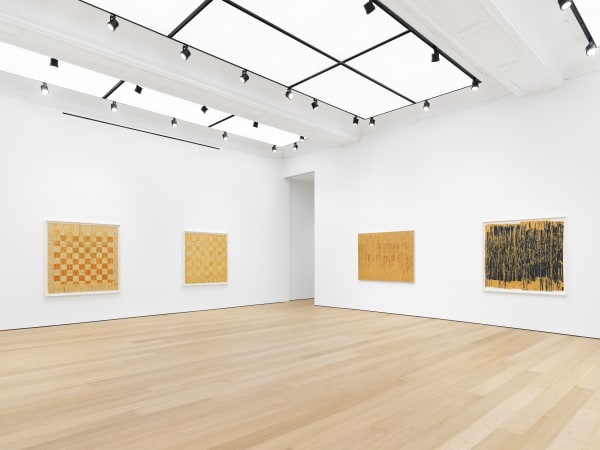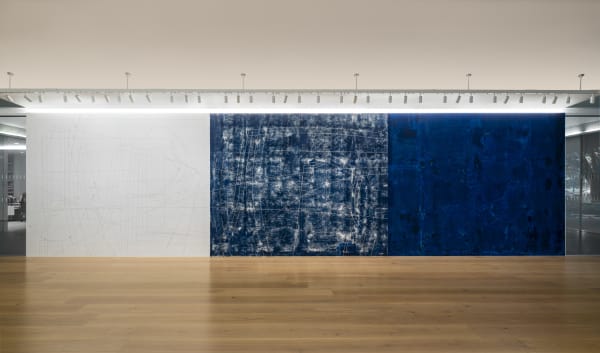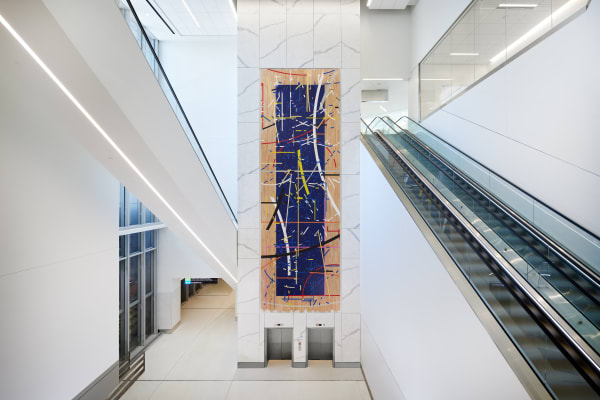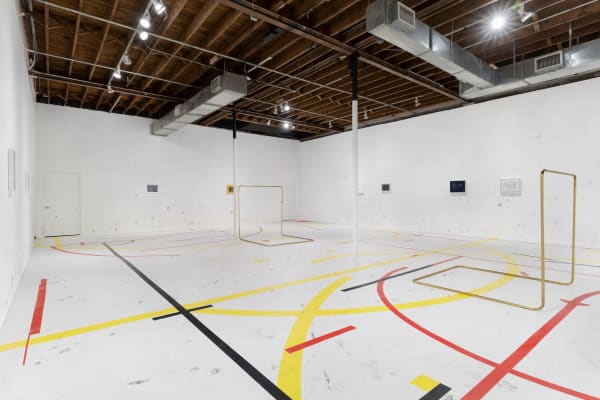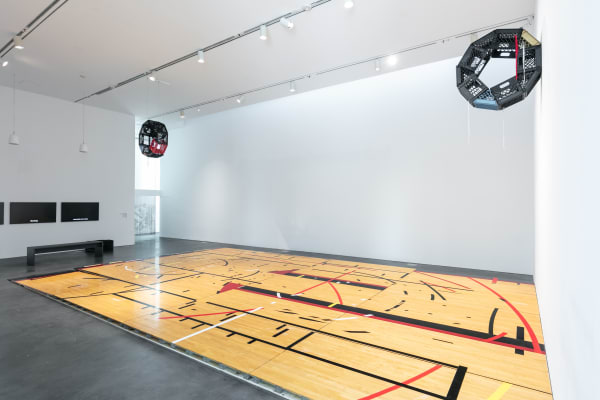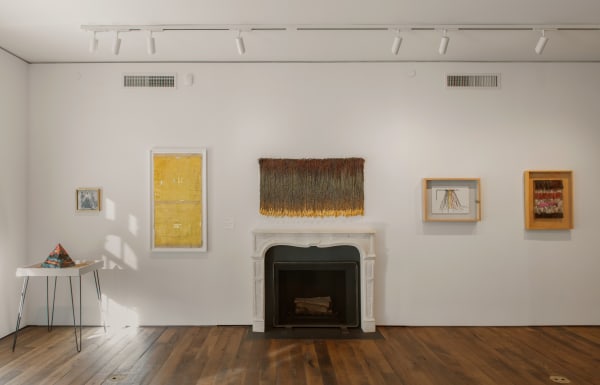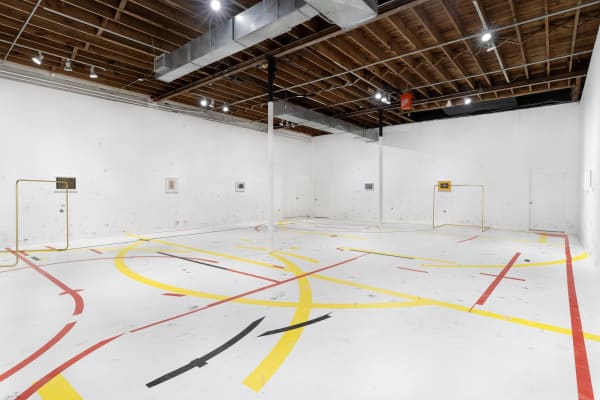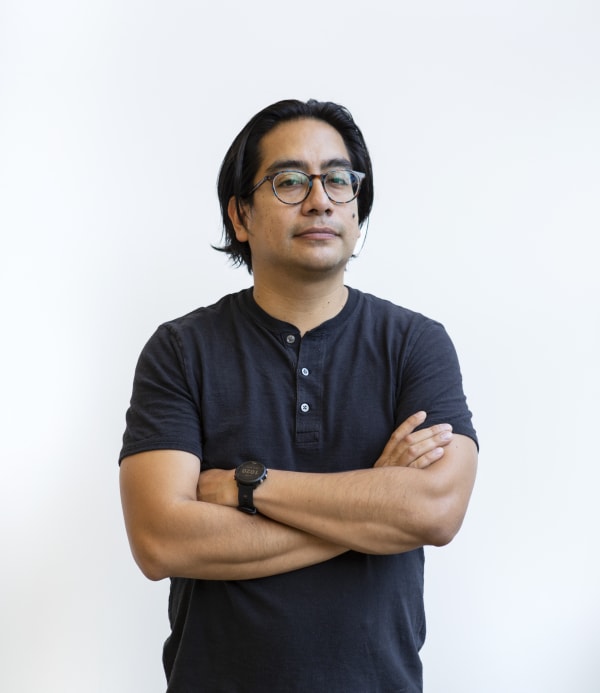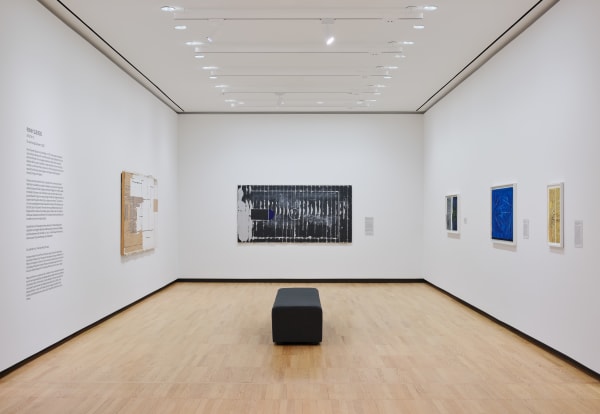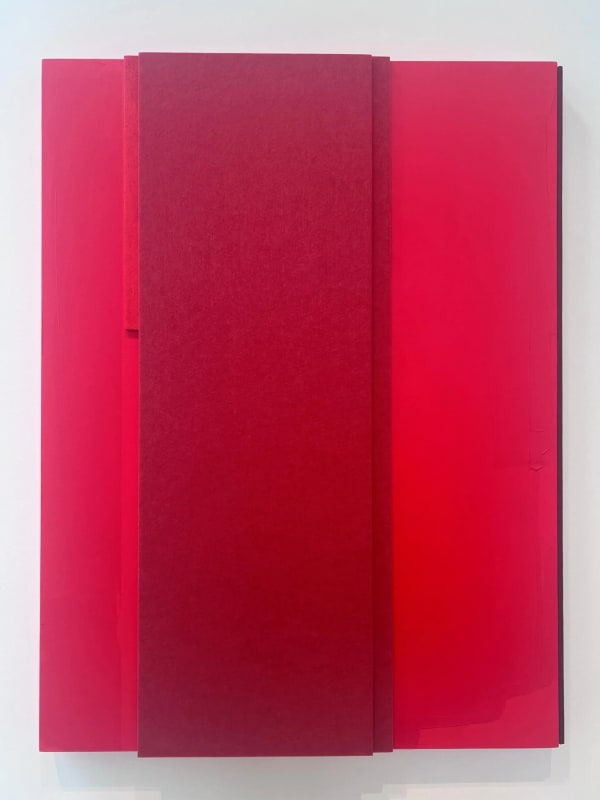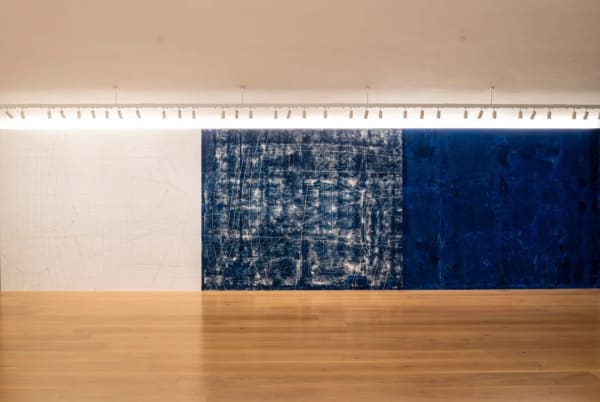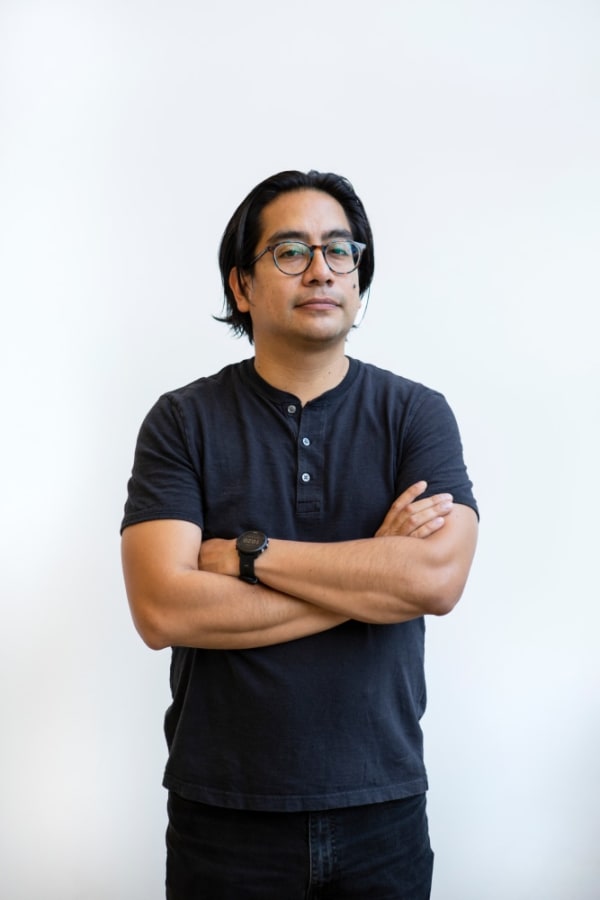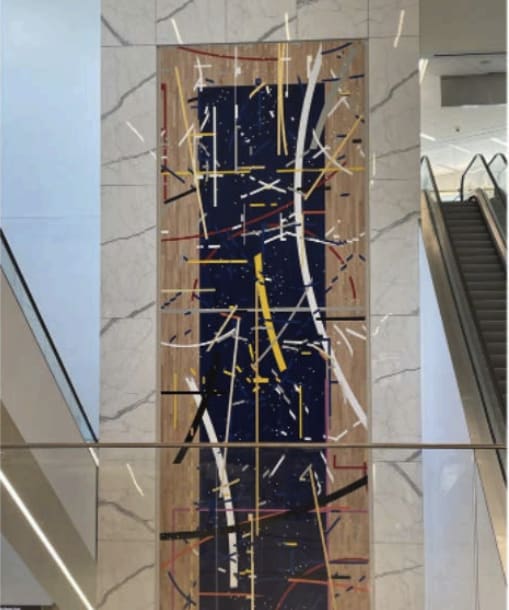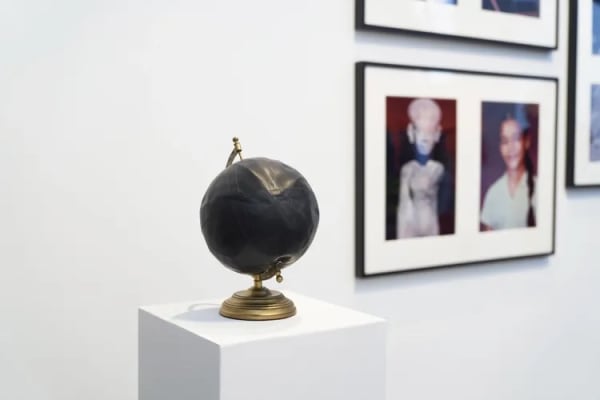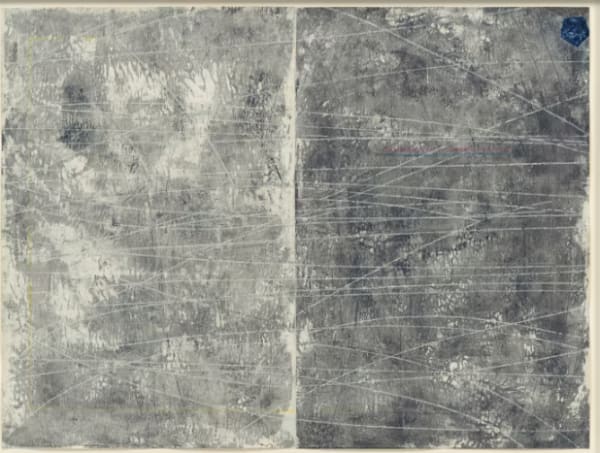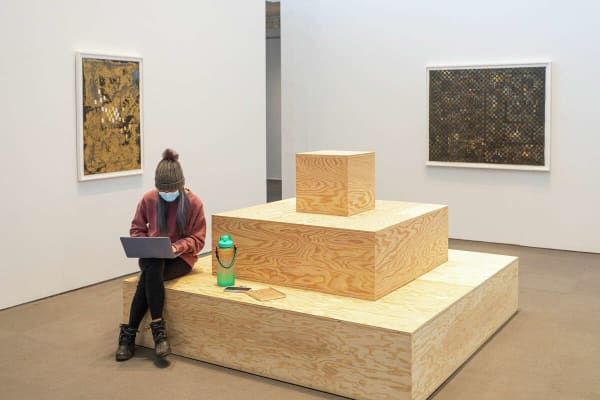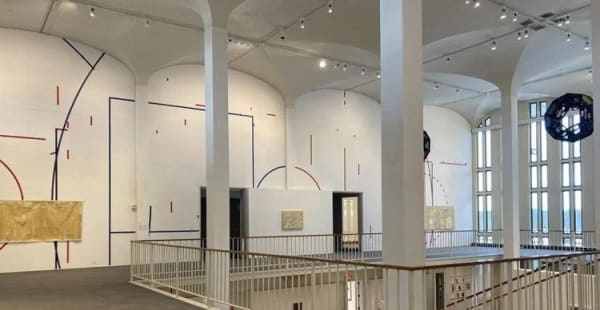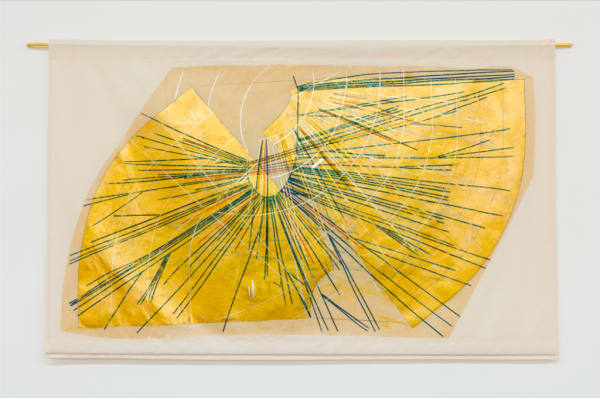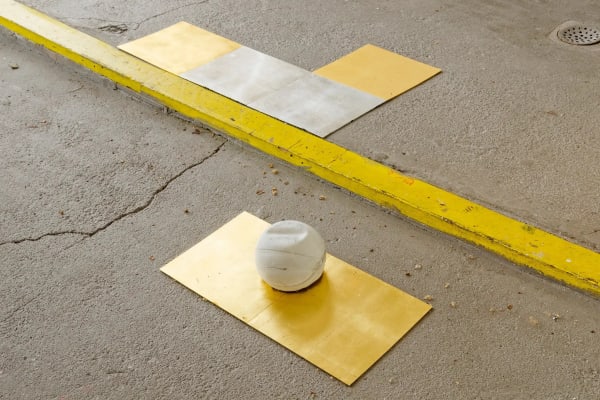Ronny Quevedo
-
Biography
Ronny Quevedo (b.1981) was born in Guayaquil, Ecuador and lives and works in New York, NY. Quevedo’s practice spans installation, drawings, and prints, incorporating and subverting aspects of abstraction, painting, collage, cartography, and sports imagery. Deeply engaged with notions of identity, Quevedo reenvisions pre- and post-colonial iconographies. The recuperation of Indigenous languages of abstraction, revalorization of their associated labor, and centering of a living connection between contemporary and centuries-old cultural markers are foundational to Quevedo’s ongoing practice.
Navigating nuanced relationships between the personal and the cultural, Quevedo’s work is rooted in his own family history. Quevedo’s father was a professional soccer player in Ecuador and the artist often incorporates the reconstructed and reorganized lines of athletic fields in his work. Similarly, the influence of Quevedo’s mother’s work as a dressmaker is evidenced in his incorporation of materials like muslin and wax tracing paper. By contextualizing these technical materials with ostensibly precious substances like gold and silver leaf, ubiquitous within Andean history, he invites the viewer to interrogate the simultaneous valuation of certain luxuries and erasure of the artisans who create them.
Central to Quevedo’s practice is the cultural heritage of the Americas. For Quevedo, pre-Columbian history “is associated with having been conquered and, thus, a sense that its culture exists in a past that is extinct. . . . When I reference Inca or Wari culture in my work, I’m looking into a cultural space and approach whose legacy continues to be influential. This is a conscious decision to resist contemporary notions of minimalism and abstraction as apolitical and asymbolic.” Positioning his works as conduits between past and present, Quevedo creates what he refers to as “portals” between peoples, cultures, and mediums. Weaving together opposing materials and diverging narratives “from the Andes to The South Bronx,” Quevedo explains, “these interpretations of a re-imagined self … give life to an ancestry of abstraction and transformational figures.”
Quevedo’s work has been the subject of numerous solo presentations, including Ronny Quevedo: a l l s t a r s, Krannert Art Museum, University of Illinois Urbana-Champaign (2025); Wall Drawing Series: Ronny Quevedo, The Menil Collection, Houston, TX (2024); Ronny Quevedo: ule ole allez, Locust Projects, Miami, FL (2022); Ronny Quevedo: offside, University Art Museum, University of Albany, NY (2022); and no hay medio tiempo / there is no halftime, Queens Museum, NY (2017), traveled to Temple Contemporary, Tyler School of Art and Architecture, Philadelphia, PA (2019), among others. In 2022, he was commissioned by Delta Air Lines in partnership with the Queens Museum to create a large-scale permanent installation at LaGuardia Airport, Queens, NY. Quevedo has participated in many group exhibitions, including Get in the Game: Sports, Art, Culture, San Francisco Museum of Modern Art, CA (2024); Movements Toward Freedom, Museum of Contemporary Art, Denver, CO (2024); Gilded: Contemporary Artists Explore Value and Worth, Weatherspoon Art Museum, University of North Carolina at Greensboro, NC (2022), traveled to Hunter Museum of American Art, Chattanooga, TN (2023), and Hood Museum of Art, Dartmouth, Hanover, NH (2024); and Pacha, Llacta, Wasichay; Indigenous Space, Modern Architecture, New Art, Whitney Museum of American Art, New York (2018). Quevedo’s work is in the collections of the Baltimore Museum of Art, MD; Buffalo AKG Art Museum, NY; Colorado Springs Fine Arts Center at Colorado College, CO; Denver Art Museum, CO; Minneapolis Institute of Art, MN; and Whitney Museum of American Art, New York, NY, among others. He is the recipient of many awards and grants, including the Trellis Art Fund Award (2024); Joan Mitchell Fellowship (2021); Jerome Hill Artists Fellowship (2019); Socrates Sculpture Park Artist Fellowship (2017); and Queens Museum/Jerome Foundation Fellowship for Emerging Artists (2016), among others.
-
Exhibitions
-

Ronny Quevedo
Composite Portals April 27 - June 15, 2024 New YorkAlexander Gray Associates, New York presents Ronny Quevedo: Composite Portals , the artist’s second solo exhibition with the Gallery. Positioning Andean textiles as conduits between the precolonial past and our...Read more -

Ronny Quevedo
entre aquí y allá September 8 - October 15, 2022 New YorkAlexander Gray Associates, New York presents Ronny Quevedo: entre aquí y allá , the Gallery’s first exhibition of the artist’s work. Featuring a new sculpture and works on muslin and...Read more
-
-
Other Exhibitions
-

Ronny Quevedo: a l l s t a r s
Krannert Art Museum August 28 - December 6, 2025Ronny Quevedo's solo exhibition a l l s t a r s at the Krannert Art Museum, University of Illinois Urbana-Champaign. The institution's press release follows: In layered, intricate drawings... -

Wall Drawing Series: Ronny Quevedo
The Menil Collection September 13, 2024 - August 10, 2025Ronny Quevedo's solo exhibition at The Menil Drawing Institute, Houston, TX. The institution's press release follows: Wall Drawing Series: Ronny Quevedo features a site-specific work by New York-based artist Ronny... -

Queens Museum Partnership with Delta Airlines and Port Authority
Terminal C at LaGuardia Airport (LGA)
Permanent InstallationRonny Quevedo among New York-based artists commisioned by the Queens Museum in partnership with Delta Airlines and Port Authority for a permanent installation at Terminal C at LaGuardia Airport, Queens,... -

El Dorado: Myths of Gold
Americas Society September 6 - December 16, 2023Ronny Quevedo featured in the group exhibition El Dorado: Myths of Gold curated by Aimé Iglesias Lukin, Tie Jojima, and Edward J. Sullivan at the Americas Society, New York, NY.... -

ule ole allez
Locust Projects November 23, 2022 - February 4, 2023Ronny Quevedo's one person exhibition ule ole allez at Locust Projects in Miami, FL. The institution's press release follows: ule ole allez , a new project by Ecuadorian-born, Queens-based artist... -

Ronny Quevedo: offside
University Art Museum at University of Albany January 25 - April 2, 2022Ronny Quevedo's one-person exhibition, Ronny Quevedo: offside, at the University Art Museum at University of Albany, NY. The institution's press release follows: The University Art Museum is pleased to present... -

Ronny Quevedo: at the line
Colorado Springs Fine Arts Center at Colorado College October 1 - December 4, 2021Ronny Quevedo's one-person exhibition, Ronny Quevedo: at the line , organized by the Colorado Springs Fine Arts Center at Colorado College, CO. The institution's press release follows: Working across printmaking,... -

Comunidades Visibles: The Materiality of Migration
Buffalo AKG Art Museum February 12 - May 16, 2021Ronny Quevedo included in the group exhibition Comunidades Visibles: The Materiality of Migration at the Buffalo AKG Art Museum, NY. The institution's press release follows: Comunidades Visibles (Visible Communities): The... -

Pacha, Llaqta, Wasichay: Indigenous Space, Modern Architecture, New Art
Whitney Museum of American Art July 13 - September 30, 2018Ronny Quevedo included in the group exhibition Pacha, Llaqta, Wasichay: Indigenous Space, Modern Architecture, New Art at the Whitney Museum of American Art, New York. The institution's press release follows:... -

no hay medio tiempo / there is no halftime
Queens Museum April 9 - August 13, 2017Ronny Quevedo's one-person exhibition, no hay medio tiempo / there is no halftime , organized by the Queens Museum, NY. The institution's press release follows: no hay medio tiempo /...
-
-
Public Collections
Baltimore Museum of Art, MD
Bowdoin College Museum of Art, Brunswick, ME
Buffalo AKG Art Museum, NY
Colorado Springs Fine Arts Center at Colorado College
Denver Art Museum, CO
The Frances Young Tang Teaching Museum and Art Gallery, Skidmore College, Saratoga Springs, NY
Minneapolis Institute of Art, MN
Museum of Old and New Art, Hobart, Tasmania, Australia
Whitney Museum of American Art, New York, NY -
Videos
-
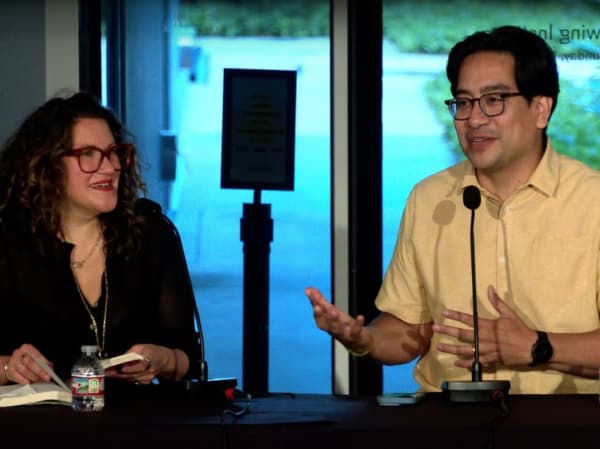
Conversation: Ronny Quevedo and Xochitl Gonzalez
The Menil Collection June 5, 2025Join artist Ronny Quevedo and author Xochitl Gonzalez for a conversation on memory and cultural narratives, drawing on their shared experiences of growing up in...Watch -
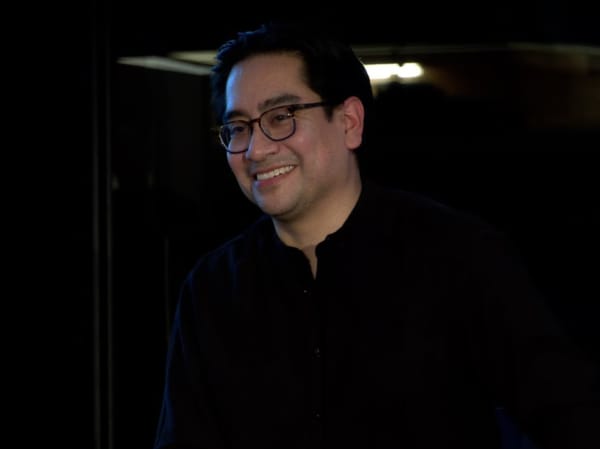
Artist Talk: Ronny Quevedo
The Menil Collection January 9, 2025Artist Ronny Quevedo joins Kelly Montana, Assistant Curator, Menil Drawing Institute, for a discussion about Quevedo’s wall drawing, 'C A R A A C A...Watch -
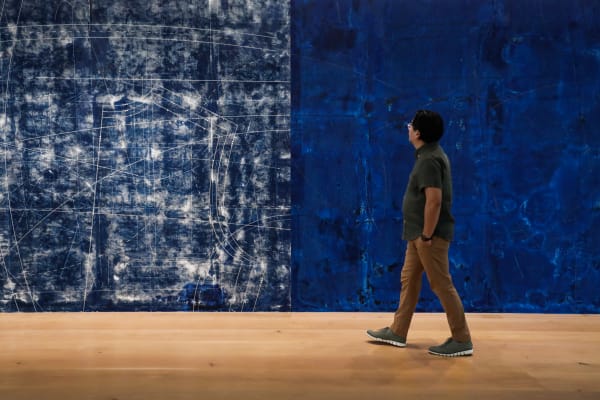
Wall Drawing Series: Ronny Quevedo
The Menil Collection October 16, 2024Wall Drawing Series: Ronny Quevedo features a site-specific work by New York-based artist Ronny Quevedo (b. 1981). The 36-foot triptych, C A R A A...Watch -
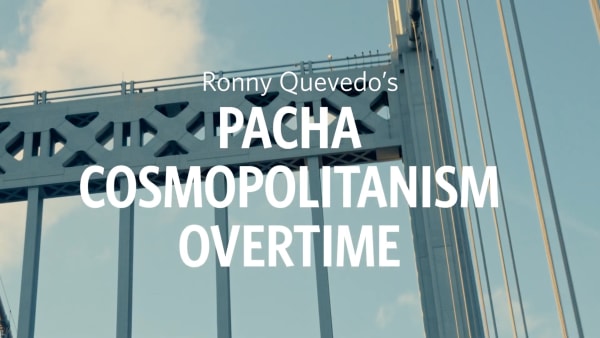
Ronny Quevedo on "Pacha Cosmopolitanism Overtime"
Queens Museum x Delta Air Lines June 1, 2022Delta Air Lines, in collaboration with Queens Museum, has commissioned six permanent art installations from renowned artists Mariam Ghani, Rashid Johnson, Aliza Nisenbaum, Virginia Overton,...Watch -
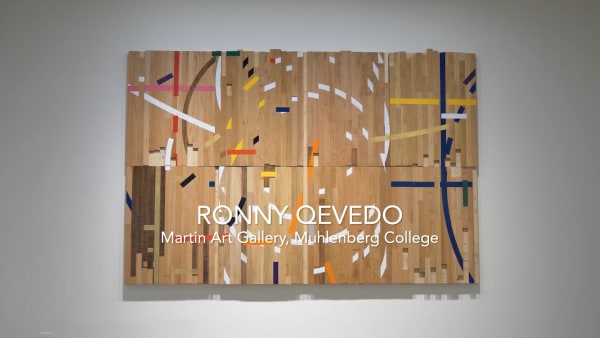
Ronny Quevedo on "Space of Play, Play of Space"
Muhlenberg College September 23, 2019”I would like people to get a sense that they’re seeing something that they recognize while at the same time seeing something that is new...Watch
-
-
News / Events
-

Ronny Quevedo and Joan Semmel
Get in the Game: Sports, Art, Culture at Pèrez Art Museum Miami March 19–August 23, 2026Ronny Quevedo and Joan Semmel are included in the group exhibition Get in the Game: Sports, Art, Culture at Pèrez Art Musuem Miami, Florida, on view from March 19–August 23, 2026.Read more -

Ronny Quevedo
Whose America? at the National Academy of Design September 13, 2025–January 26, 2026Ronny Quevedo is included in the group exhibition Whose America? at the National Academy of Design, New York, New York, on view from October 16, 2025–January 10, 2026.Read more -

Ronny Quevedo and Joan Semmel
Get in the Game: Sports, Art, Culture at Crystal Bridges Museum of American Art September 13, 2025–January 26, 2026Ronny Quevedo and Joan Semmel are included in the group exhibition Get in the Game: Sports, Art, Culture at Crystal Bridges Museum of American Art, Arkansas, on view from September 13, 2025–January 26, 2026.Read more -

Ronny Quevedo: a l l s t a r s
Krannert Art Museum August 28–December 6, 2025Ronny Quevedo's solo exhibition, a l l s t a r s at Krannert Art Museum, Illinois, will be on view from August 28–December 6, 2025.Read more -

Ronny Quevedo
Verde-Distância at the 2nd Bienal das Amazônas August 29–November 30, 2025Ronny Quevedo is included in the group exhibition Verde-Distância at the 2nd Bienal das Amazônas, Belém, Brazil, on view from August 29–November 30, 2025.Read more -

Artist Talk: Ronny Quevedo
The Menil Collection January 9, 2025, 7:00–8:00 PMArtist Ronny Quevedo joins Kelly Montana, Assistant Curator, Menil Drawing Institute, for a discussion about Quevedo’s wall drawing, C A R A A C A R A, 2024. This drawing is the sixth in an ongoing series of ephemeral, site-specific installations at the Menil Drawing Institute.Read more -

The Writing’s on the Wall: Language and Silence in the Visual Arts
Hill Art Foundation December 12, 2024–March 29, 2025Jennie C. Jones and Ronny Quevedo are included in the group exhibition, The Writing’s on the Wall: Language and Silence in the Visual Arts at...Read more -

Ronny Quevedo and Joan Semmel
Get in the Game: Sports, Art, Culture at the San Francisco Museum of Modern Art (SFMoMA) October 19, 2024−February 18, 2025Ronny Quevedo and Joan Semmel are included in the group exhibition, Get in the Game: Sports, Art, Culture at the San Francisco Museum of Modern Art, California, on view from October 19, 2024–February 18, 2025.Read more -

Ronny Quevedo
Movements Toward Freedom at Museum of Contemporary Art, Denver (MCA Denver) September 20, 2024–February 2, 2025Ronny Quevedo is included in the group exhibition, Movements Toward Freedom at Museum of Contemporary Art, Denver (MCA Denver), Denver, Colorado, on view from September...Read more -

Ronny Quevedo: Wall Drawing Series
The Menil Collection September 13, 2024–August 10, 2025The Menil Collection has commissioned New York-based artist Ronny Quevedo (b. 1981) to create the Menil Drawing Institute’s sixth artwork for its ongoing Wall Drawing...Read more -

Ronny Quevedo
Body Maps: Works from the University at Albany Fine Art Collections in Conversation with Past Exhibiting Artists at University Art Museum, University at Albany January 22–April 3, 2024Read moreRonny Quevedo is included in a group exhibition, Body Maps at the University Art Museum in Albany, New York.
-

Ronny Quevedo
Spin a Yarn at ANOTHER SPACE November 10, 2023–March 15, 2024Read moreRonny Quevedo is included in a group exhibition, Spin a Yarn at ANOTHER SPACE in New York.
-

Ronny Quevedo
Gilded: Contemporary Artists Explore Value and Worth at Hunter Museum of American Art September 22, 2023–January 8, 2024Read moreRonny Quevedo is included in a group exhibition, Gilded: Contemporary Artists Explore Value and Worth at the Hunter Museum of American Art, Chattanooga, Tennessee.
-

Ronny Quevedo
El Dorado: Myths of Gold at Americas Society September 6, 2023–May 18, 2024Read moreRonny Quevedo is included in a group exhibition, El Dorado: Myths of Gold at Americas Society, New York.
-

Ronny Quevedo
Lux et Veritas at Nova Southeastern University Art Museum, Fort Lauderdale April 2–January 8, 2023Read moreRonny Quevedo's group exhibition Lux et Veritas curated by Bonnie Clearwater at Nova Southeastern University Art Museum Fort Lauderdale in Florida.
-

Ronny Quevedo: ule ole allez
Locust Projects November 29, 2022–February 04, 2023Read moreRonny Quevedo's one person exhibition ule ole allez at Locust Projects in Miami, FL.
-

Ronny Quevedo
Gilded: Contemporary Artists Explore Value and Worth at Weatherspoon Art Museum September 10, 2022–April 8, 2023Read moreRonny Quevedo included in the group exhibition Gilded: Contemporary Artists Explore Value and Worth at the Weatherspoon Art Museum.
-

Ronny Quevedo
A New Way to Travel: Delta Air Lines x Queens Museum at LaGuardia Airport at Queens Museum June 1, 2022–April 16, 2023Read moreRonny Quevedo included in group show A New Way to Travel: Delta Air Lines x Queens Museum at LaGuardia Airport at the Queens Museum, NY with corresponding works on view for permanent installation at LaGuardia Airport.
-

In Conversation: Ronny Quevedo and Rodrigo Valenzuela
University Art Museum at University of Albany March 3, 2022Read moreRonny Quevedo in conversation with Rodrigo Valenzuela, another exhibiting artist at the University Art Museum at the University of Albany, NY.
-

Ronny Quevedo
Alexander Gray Associates February 2, 2022Read moreAlexander Gray Associates announces representation of Ronny Quevedo (b.1981). Quevedo’s practice spans installation, drawings, and prints, incorporating and subverting aspects of abstraction, painting, collage, cartography, and sports imagery.
-

Ronny Quevedo
ReVisión: Art in the Americas at Denver Art Museum October 24, 2021–July 17, 2022Read moreRonny Quevedo included in the group exhibition ReVisión: Art in the Americas at the Denver Art Museum in Denver, CO.
-
-
Articles / Reviews
-

Step into Ronny Quevedo’s world where nothing stays in one place
Smile PolitelyOctober 6, 2025 The Krannert Art Museum’s a l l s t a r s exhibit arrives at a perfect moment, just as... -

Ronny Quevedo Connects Sites of Cosmovisions at Krannert Art Museum
NewCity ArtSeptember 9, 2025 Soccer fields, garment papers and Andean objects get delineated as sites of inheritance, revalorization and cosmovisions in “Ronny Quevedo: a... -

Ecuadorian artist Ronny Quevedo in a "C A R A A C A R A" with his past and his present
El UniversalMay 4, 2025 The artist Ronny Quevedo , born in Guayaquil, Ecuador , in 1981 confronts the evolution of the drawing technique, but... -

How Do You Paint Language?
HyperallergicMarch 17, 2025 Reviewing The Writing’s on the Wall: Language and Silence in Visual Arts feels like offering water to the ocean. Curated... -

The Menil’s Wall Drawing Series Challenges Views of Illustration
HoustoniaJanuary 23, 2025 The Menil Drawing Institute occupies a unique niche in Houston’s visual arts scene. Its explicit role revolves around promoting drawing... -

TRELLIS ART FUND ANNOUNCES INAUGURAL GRANTEES
ArtforumJuly 22, 2024 The Trellis Art Fund , which launched in Februrary with a $15.8 million endowment and the goal of supporting individual... -

Go to the New La Guardia for the Art
CurbedJune 14, 2023 Bookending the other end of the atrium is a monumental wall installation by Bronx native Ronny Quevedo called Pacha Cosmopolitanism... -

Reflections of Time & Place
Metropolitan Airport NewsMay 10, 2023 Ronny Quevedo’s, Pacha Cosmopolitanism Overtime incorporates the floors of gymnasiums that are painted in a way that draws a parallel... -

Your Concise Guide to Miami Art Week
HyperallergicNovember 28, 2022 As some of us recall with a distinct mix of nostalgia and discomfort, the bar for peak Miami-ness was set... -

Your Guide to the Best Events at Miami Art Week and Art Basel 2022
W MagazineNovember 23, 2022 Ronny Quevedo at Locust Projects When: Beginning November 29 Where: Locust Projects gallery, 3852 N Miami Ave. What to Expect:... -

Defiantly at Home: Latinx Artists in the Borderlands
Art in AmericaNovember 21, 2022 Photojournalism from the US-Mexico border currently emphasizes stark, divisive images: walls, fences, surveillance devices, border patrols, “coyotes,” and crossing migrants.... -

5 Latinx Artists Using Abstraction to Address Precolonial Histories
ArtsyOctober 6, 2022 In her article “Witnessing the In-visibility of Inca Architecture in Colonial Peru” (2007), Stella Nair describes how 16th-century Spanish colonists... -

Video: Ronny Quevedo: entre aquí y allá
The Brooklyn RailSeptember 20, 2022 Artist Ronny Quevedo joins Rail Editor-At-Large Jason Rosenfeld for a conversation. We conclude with a poetry reading by Amish Trivedi.... -

NSU Art Museum’s “Lux et Veritas” Brings Plenty of Light & Truth
Boca Raton MagazineJuly 22, 2022 The artists in “Lux et Veritas,” an exciting exhibition at the NSU Art Museum in Fort Lauderdale, share two things... -

LaGuardia Airport's New Terminal Will Boast a $12 Million USD Art Initiative
HypebeastJune 3, 2022 There are very few places on Earth that muster the wide range of emotions found at the airport. Excitement, dread,... -

New York’s LaGuardia Airport Unveils New Permanent Artworks by Mariam Ghani, Rashid Johnson, and Others
artnet NewsJune 2, 2022 For the second time in as many years, New York has opened a new, state-of-the-art terminal at Queens’s formerly decrepit... -

The Renovated LaGuardia Airport Abounds With Artwork
Surface MagazineJune 2, 2022 LaGuardia has long been considered the armpit of New York’s airports. President Joe Biden famously compared its decrepit facilities to... -

From Latinx artists to new takes on Surrealism, curator Marcela Guerrero’s favourite works at Frieze New York
The Art NewspaperMay 19, 2022 Marcela Guerrero, an associate curator at the Whitney Museum of American Art, is spearheading two major exhibitions this year: No... -

Latinx artists finally get New York recognition
Financial TimesMay 12, 2022 It seems as though everywhere one looks in New York City, Latinx artists are making their mark. In April, El... -

Down the Line
Art in AmericaMay 9, 2022 “Lineage” might bring to mind bloodlines, family trees, inherited customs, and archives indicating how an individual relates to a larger... -

'Offside' at UAlbany a personal, cultural exhibit
Times UnionFebruary 28, 2022 For the artist Ronny Quevedo, whose family moved from Ecuador to New York when he was just a year old,... -

Six NY artists to create art installations for LaGuardia Airport's new terminal
Telemundo 47February 22, 2022 New York has selected six world-renowned artists to create permanent art installations at the new $4 billion Terminal C at... -

On Exhibit: Unseen labor cleverly highlighted in UAlbany works
The Daily GazetteJanuary 26, 2022 “Ronny Quevedo: offside,” one of the latest exhibits to open at the University Art Museum, is deceptively sparse on first... -

Ronny Quevedo: at the line
DARIANovember 19, 2021 The show currently on view in the Central and South El Pomar Galleries at the Colorado Springs Fine Arts Center... -

Colorado Springs Fine Arts center Museum to present Quevedo exhibit Oct. 1
Fox 21 NewsAugust 26, 2021 COLORADO SPRINGS, Colo. — Ronny Quevedo’s art is coming to the Colorado Springs Fine Arts Center at Colorado College in... -

Editors’ Picks: 21 Things Not to Miss in New York’s Art World This Week
artnet NewsFebruary 24, 2020 16. “Metallica ” at Foxy Production Don’t get the wrong idea: this is not a show about James Hetfield, Lars... -

Looking at Sports as Powerful Modes of Expression
HyperallergicAugust 19, 2019 ALBANY, New York — More than a few associations come to mind with Kevin Beasley’s “Rose” (2017). The installation includes... -

'ACE' exhibit at University at Albany art museum
Times UnionJuly 25, 2019 Most of the work on display in 'ACE: art on sports, promise, and selfhood' at the University Art Museum at... -

Spring Gallery Guide: Brooklyn
The New York TimesApril 26, 2019 Like so much else in Brooklyn these days, the art scene there seems to be in flux. Galleries that were... -

Making Space: Ronny Quevedo Interviewed by Louis Bury
BOMB MagazineApril 22, 2019 Ronny Quevedo’s work uses abstraction to address personal and political themes with suggestive intricacy. His drawings, prints, and installations scramble... -

What to See in New York Art Galleries This Week
The New York TimesSeptember 13, 2018 ‘Pacha, Llaqta, Wasichay’ Through Sept. 30. Whitney Museum of American Art, 99 Gansevoort Street, Manhattan; 212-570-3600, whitney.org . Modernism, as... -

Latinx Artists Are Highlighted for the First Time in a Group Show at the Whitney
HyperallergicAugust 28, 2018 Pacha, Llaqta, Wasichay: Indigenous Space, Modern Architecture, New Art , curated by Marcela Guerrero, along with curatorial project assistant Alana... -

A Vision of US Immigration Beyond the Melting Pot
HyperallergicAugust 7, 2017 Ronny Quevedo ’s no hay medio tiempo / there is no halftime exhibition at the Queens Museum revolves around a... -

Ronny Quevedo’s Field of Play
HyperallergicJuly 8, 2017 In his classic 1938 study of play in human culture, Homo Ludens , Dutch anthropologist Johan Huizinga draws a parallel... -

Critics' Picks: Harold Mendez and Ronny Quevedo
ArtforumSeptember 22, 2015 A small copper reproduction of a pre-Columbian death mask rests inside a burned cardboard box. This tableau is the opening...
-


